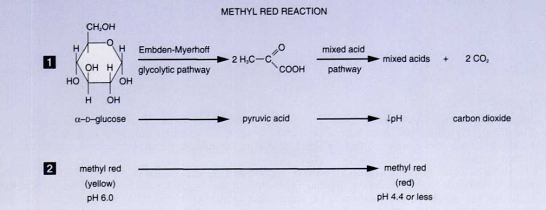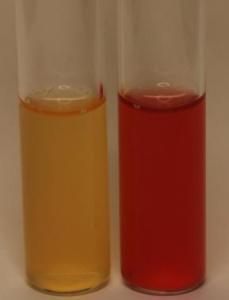Methyl Red (MR) Test: Principle, Procedure, and Results
Methyl Red (MR) test determines whether an organism performs mixed acid fermentation and produces stable acid end products. Methyl red is the indicator that detects the pH after an enteric Gram-negative rod has fermented glucose to completion.
Did you Know? Clark and Lubs formulated the media for MR and VP tests.
Table of Contents
Principle of Methyl Red (MR) Test
In mixed acid fermentation, bacteria form significant acids (acetic, lactic, and succinic), decreasing the medium’s pH below 4.4. It is visualized by using a pH indicator, methyl red (2-[[4-(dimethylamino)phenyl]diazenyl]benzoic acid), a pH indicator which is red at pH ≤ 4.4, and yellow color at pH 5.8.

- MR Positive: The culture medium turns red (because the pH of the medium is at or below 4.4 from the fermentation of glucose).
- MR Negative: Culture medium remains yellow (less acid is produced from the fermentation of glucose).
Media and Reagents
The media used in the test is methyl red-Voges-Proskauer (MR/VP) broth. Media and reagents can be prepared in-house or purchased from commercial providers.
The composition of MR/VP broth is as follows:
- Firstly, dissolve 0.1 g of MR in 300 ml of 95% ethyl alcohol.
- After that, add sufficient distilled water to make 500 ml.
- Then, store at 4 to 8°C in a brown bottle.
- The solution is usable for one year.
Quality Control for MR Test
After preparing or procuring each lot of medium, examine the broth for signs of contamination, dehydration, and deterioration. Perform performance testing of media and reagent before use with one organism known to demonstrate a positive reaction and one known to give a negative reaction.
Organisms
- Escherichia coli ATCC 25922—MR positive (red)
- Klebsiella pneumoniae ATCC 13883—MR negative (yellow)
Procedure for Methyl Red (MR) Test
- Firstly, bring the MR-VP broth to room temperature.
- Then, inoculate two tubes containing MR-VP broth with a pure culture of the microorganisms under investigation.
- After that, incubate the broth medium at 35 °C for at least 48 hours.
- Then, add five drops of the methyl red indicator solution to the first tube. The second tube is for the Voges-Proskauer test. Barritt’s reagent is used for the test.
- Finally, observe for change in color in any of the tubes.

Expected results of MR Test
The development of a stable red color on the surface of the medium with MR reagent indicates sufficient acid production to lower the pH to 4.4 and constitutes a positive test. Because other organisms may produce smaller quantities of acid from the test substrate, an intermediate orange color between yellow and red may develop. It does not indicate a positive test.
- Escherichia coli (MR test positive): the appearance of red color after adding methyl red reagent.
- Klebsiella (formerly Enterobacter) aerogenes (MR test negative): the lack of color change after adding methyl red.
- Organisms in the E. coli group are MR positive, whereas those in the Enterobacter- Klebsiella group are MR negative.
- Most members of the family Enterobacteriaceae give opposite MR and VP reactions. However, certain organisms, like Hafnia alvei and Proteus mirabilis, may give both a positive MR reaction and a positive VP reaction (often delayed).
Methyl Red (MR) positive organisms
- Escherichia coli
- Shigella species
- Salmonella species
- Citrobacter species
- Proteus species
- Yersinia species
Methyl Red (MR) negative organisms
- Enterobacter species
- Hafnia species
- Serratia marcescens
- Klebsiella pneumoniae
Limitations
- Avoid over-inoculation because it increases the number of viable cells. Bacterial growth is inhibited when the inoculum exceeds 10 9 viable cells per ml.
- Also, incubating the tubes for insufficient time may result in a false-positive MR test.
References and further readings
- Clinical Microbiology Procedures Handbook, Fourth Edition. (2016). In Clinical Microbiology Procedures Handbook, Fourth Edition. American Society of Microbiology. https://doi.org/10.1128/9781555818814
- Color Atlas and Textbook of Diagnostic Microbiology, Koneman, 5th edition



